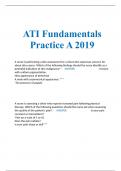MDCL - Management Accounting: Decision & Control
MDCL - Management Accounting: Decision & Control
Chapter 1 - Cost classification and behaviour 2
Types of costs 2
Cost classification (type, function, nature) 3
Cost classification (direct, indirect) 4
Responsibility centres 4
Indirect cost allocation and apportionment 4
Absorption costing 4
Activity based costing (ABC) 5
Chapter 2 - Statistical techniques 5
Time series analysis 5
Moving averages 6
Linear regression 7
Index numbers 7
Uncertainties in forecasting 8
Chapter 3 - Standard costing 8
Standard cost 8
Setting standard costs 9
Types of standards 9
Business operations with standard costing 9
Chapter 4 - Variance analysis 10
Materials variances 10
Labour variances 10
Overhead variances 11
Fixed overhead variances 11
Chapter 5 - Operating Statements 11
Reconciling under absorption costing 11
Reconciling under marginal costing 12
Chapter 6 - Interpreting variances 12
Causes of variances 12
Un/controllable variances 13
Chapter 7 - Performance Indicators 13
Financial performance indicators 13
Ratio analysis 14
Profitability 15
Liquidity ratios 15
Use of resources 16
Financial position 17
Limitations 17
Non- financial performance indicators 18
Balanced scorecard 19
, MDCL - Management Accounting: Decision & Control
Quality 19
Chapter 8 - Cost Management 20
Product lifecycle 20
Lifecycle costing 21
Target costing 22
Value analysis and value engineering 22
Sustainability 22
Chapter 9 - Activity Based Costing (ABC) 23
Overhead absorption rate (OAR) 23
Calculating 23
Advantages and Disadvantages 24
Chapter 10 - Decision-Making Techniques 24
Breaking even 24
Cost-volume-profit (CVP) analysis 25
Limiting factor analysis 25
Make or buy decisions - financial 26
Make or buy decisions - non-financial 26
Shutdown decisions 26
Mechanisation decisions 26
Long-term decisions making 27
, MDCL - Management Accounting: Decision & Control
Chapter 1 - Cost classification and behaviour
Types of costs
Budget = a formalised, numerical plan of action for a business
- Represents what a business wants to achieve
- A plan and a performance measure
Creating a budget
- Costs allocated to be direct or indirect (see below)
- Direct = relating to specific units of products or services
- Indirect = costs that can’t be attributed directly to a cost unit
- Costs allocated to variable, semi-variable, fixed and stepped (cost against output)
- Variable = vary with output, e.g. product materials
- Fixed = costs that will not vary with output, e.g. fixed overheads, rent
- Stepped fixed = costs that remain fixed for a certain level of output and then
increase until a further level of output is reached, e.g. rent, supervisors costs
- Semi-variable = costs which are part fixed and part variable and are therefore
partly affected by changes in activity levels, e.g. telephones
Semi-variable costs
- Has a fixed and variable element
- Total cost = fixed element + (variable cost per unit x no. of units)
- High-low method for semi-variable costs
1. Select highest and lowest unit outputs and their costs
2. Find the difference between these figures (H - L = d)
3. Calculate variable cost per unit (VC = d units/d cost)
4. Calculate fixed cost using a precalculated figure [TC=FC + (VC x no. of units)]
Cost classification (type, function, nature)
Cost classification = arrangement of cost items into logical groups, e.g:
, MDCL - Management Accounting: Decision & Control
- Type = capital expenses, revenue expenses, etc.
- Capital = a non-current asset on the SOFP
- Purchase of NCA, improvement of earning capability of NCA
- Revenue = a cost on the SPL
- Purchase of goods for resale, maintenance of NCA, costs in running
the business
- Function = admin, production, etc.
- Production = costs associated with productions of goods/services, from raw
materials to warehousing the finished goods
- Non-production = all other costs incurred in the business
- Nature = materials, wages, etc.
- Production costs can be split into:
- Materials = cost of materials using in making the product/service
- Labour = cost of workforce in making the product
- Overheads = cost of required overheads to support the production
- Non-production costs can be split into:
- Marketing = costs incurred in promoting and retaining customers
- Distribution = costs incurred in packaging the product for despatch
- Finance = costs incurred to finance the business
- Admin = all other costs incurred in managing the business
Cost classification (direct, indirect)
Direct = costs that can be specifically identified w/, and allocated to, a single cost unit
- Generally variable, e.g. materials, but can be fixed, e.g. tool hire
- Generally production, but can be non-production, e.g. sales commission
- Prime cost = totals of all direct costs in manufacturing a product/providing a service
Indirect = costs incurred in the course of making a product/service, but can’t be identified w/
a particular cost unit
- Generally overheads and so fixed, but can be variable, e.g. oil for machinery
- Can be both production, e.g. oil and non-production, e.g. supervisors, rent, insurance
Responsibility centres
Used to structure a budget by various departments and functions are classified by their
purpose and responsibility
- Can be split into cost centres or profit centres
- Each will have budgets and actuals to compare to monitor and control performance
Cost centres = areas of a business where costs are incurred, e.g. factory
- Different in each business but exam focuses on factory
- These costs are then split into:
- Production cost centres = directly involved in the production or provision of
the cost unit, e.g. assembly department
- Service cost centres = not involved in the production or provision of the cost
unity, e.g. canteen
Profit centres = areas of a business accountable for costs and revenues, e.g. sales
- Revenue centres = areas of a business accountable for revenue only
- Investment centres = profit centres with capital investment responsibilities, e.g. a
separate division that produces, sells and despatches





